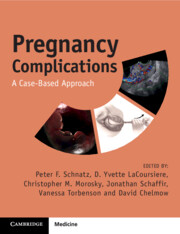Book contents
- Pregnancy Complications
- Pregnancy Complications
- Copyright page
- Contents
- Contributors
- Preface
- Note from the Editor-in-Chief
- Normal Laboratory Values (Conventional Units) []
- Section 1 Antepartum (Early Pregnancy)
- Section 2 Antepartum (Mid-trimester)
- Section 3 Antepartum (Late Pregnancy)
- Section 4 Antepartum (Medical Complications)
- Section 5 Antepartum (Infectious Complications)
- Case 39 A 30-Year-Old at 14 Weeks’ Gestation Presents after Exposure to a Child with CMV
- Case 40 A 20-Year-Old with Positive Rapid Plasma Reagin on Initial Prenatal Labs
- Case 41 A 35-Year-Old at 26 Weeks’ Gestation Presents with Fever and Diarrhea after Shopping at a Farmer’s Market
- Case 42 A 20-Year-Old with a History of Herpes Presents for a New Obstetrical Visit
- Case 43 A 40-Year-Old at 16 Weeks’ Gestation Whose Toddler Has Chicken Pox
- Case 44 A 35-Year-Old at 19 Weeks’ Gestation Whose Toddler Was Diagnosed with Parvovirus
- Case 45 A 20-Year-Old Presents at 12 Weeks’ Gestation with Septic Arthritis and Petechial Skin Rash
- Section 6 Intrapartum/Delivery
- Section 7 Postpartum
- Section 8 Fetal Complications
- Section 9 Placental Complications
- Section 10 Complications of the Cord, Amnion, and Gravid Uterus
- Section 11 Psychosocial Considerations
- Index
- References
Case 44 - A 35-Year-Old at 19 Weeks’ Gestation Whose Toddler Was Diagnosed with Parvovirus
from Section 5 - Antepartum (Infectious Complications)
Published online by Cambridge University Press: 08 April 2025
- Pregnancy Complications
- Pregnancy Complications
- Copyright page
- Contents
- Contributors
- Preface
- Note from the Editor-in-Chief
- Normal Laboratory Values (Conventional Units) []
- Section 1 Antepartum (Early Pregnancy)
- Section 2 Antepartum (Mid-trimester)
- Section 3 Antepartum (Late Pregnancy)
- Section 4 Antepartum (Medical Complications)
- Section 5 Antepartum (Infectious Complications)
- Case 39 A 30-Year-Old at 14 Weeks’ Gestation Presents after Exposure to a Child with CMV
- Case 40 A 20-Year-Old with Positive Rapid Plasma Reagin on Initial Prenatal Labs
- Case 41 A 35-Year-Old at 26 Weeks’ Gestation Presents with Fever and Diarrhea after Shopping at a Farmer’s Market
- Case 42 A 20-Year-Old with a History of Herpes Presents for a New Obstetrical Visit
- Case 43 A 40-Year-Old at 16 Weeks’ Gestation Whose Toddler Has Chicken Pox
- Case 44 A 35-Year-Old at 19 Weeks’ Gestation Whose Toddler Was Diagnosed with Parvovirus
- Case 45 A 20-Year-Old Presents at 12 Weeks’ Gestation with Septic Arthritis and Petechial Skin Rash
- Section 6 Intrapartum/Delivery
- Section 7 Postpartum
- Section 8 Fetal Complications
- Section 9 Placental Complications
- Section 10 Complications of the Cord, Amnion, and Gravid Uterus
- Section 11 Psychosocial Considerations
- Index
- References
Summary
Fifth disease is the colloquial name for the common childhood exanthema erythema infectiosum. It is caused by infection with parvovirus B19, which is typically transmitted through respiratory secretions and hand-to-mouth contact. Approximately 20–25% of individuals are asymptomatic during viral replication and shedding, while others exhibit nonspecific symptoms such as fever, sore throat, headaches, and myalgias. Following antibody development, patients may develop symptoms more specific to parvovirus B19, such as the classic “slapped cheek” rash or joint pain. When pregnant women are exposed to parvovirus B19, serologic testing is performed to determine their immune status and the potential risk to the fetus. Previous infection confers lifelong immunity, but infection during pregnancy can result in transplacental transmission. Most cases of transplacental transmission resolve without complications, however, some result in nonimmune hydrops fetalis or fetal loss. When serologies are concerning for acute maternal infection, serial ultrasounds are performed to assess the fetus for signs of hydrops fetalis. Middle cerebral artery Doppler studies assess for signs of fetal anemia and potential need for intrauterine transfusion. Pregnancies complicated by hydrops fetalis should be managed at a tertiary care facility with experience in managing hydropic neonates as their resuscitation is often complicated.
Keywords
- Type
- Chapter
- Information
- Pregnancy ComplicationsA Case-Based Approach, pp. 134 - 136Publisher: Cambridge University PressPrint publication year: 2025

